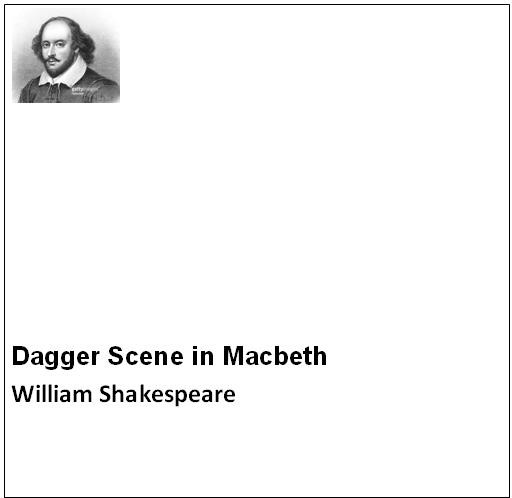
(Keywords: dagger, tragedy, Macbeth)
The dagger scene (Act-ii, Scene-i) is one of the most important scenes or parts of the tragedy ‘Macbeth’ by William Shakespeare. The scene immediately precedes the murder of King Duncan. This scene displays the moment of suspense and the moment of tension before the murder of Duncan. Here, the readers will find that Macbeth, leaving his entire dilemma now becomes resolute to murder Duncan. The readers find that when Banquo whose mind was greatly disturbed by the prophecies of the ‘three weird sisters’ takes the leave of Macbeth, he (Macbeth) moves towards the chamber of the king. Now the readers see that Macbeth is bent on killing who is in profound sleep. The transformation of Macbeth’s innocent and brave self into the vicious self of a murderer is about to start. Brave and valiant soldier Macbeth is completely stranger to the path of crime and for the first time in his life, he is going to murder a completely innocent soul from whom he has received nothing but honor,name, rank and fame.The mind of Macbeth is full of terror that is obvious for a noble man who is going to commit his first and fatal crime like the murder of Duncan, the king of Scotland. And all his tension, anxiety, the inner sense of guilt and mental agitation take the shape of a dagger. The spectacle of Macbeth’s soliloquizing and trying to catch the hold of the dagger adds tension immensely to the suspense of the scene.
The period of Macbeth’s moral conflict is over, and the dagger of the imagination is only suggestive to the urgency of the task on his hand. As he determined to kill the king the horrid image of bloody murder no longer makes the “seated heart knock at my ribs against the use of nature.” But now he is the state of hallucination.
“Is this a dagger, which I see before me”
And he dismisses the dagger as a projection of his “heat oppressed brain.” Macbeth does not believe his eyes and utters:
“Mine eyes are made the fools o’ th’ other senses.”
His eyes and senses are at odd.
The placement of the scene is very important for the logical advancement of the plot of this tragic-drama. The scene is placed between the planning of the king’s murder and the fulfilment of it. The scene conveys the message to the viewers or the readers that the murder of the king Duncun is inevitable. The vision of the gouts of blood on the blade and the dudgeon suggest that the “bloody business” must be performed. At this point Macbeth associates himself with all that is evil.
“Thus to mine eyes.-Now o’er the one half-world/ Nature seems dead, and wicked dreams abuse / The curtain’d sleep:”
His silent and stealthy steps towards Duncan’s chamber reminded him of the fetal steps of Tarquin, going to rape Lucrece. He thinks of the witches, the ‘three weird sisters’, engaged in the celebration of Hecate, the goddess of the underworld. His own movements remind him of the movements of the ghosts. He cannot associate himself with anything that sustains life.
“and wither’d Murder, /Alarum’d by his sentinel, the wolf, / Whose howl’s his watch,”
Macbeth’s soliloquy builds up the setting for the murder and reflected his state of mind. Moreover, it dramatizes the conflict between appearance and reality which is at the centre of the theme of the play. Macbeth knows that the dagger is directing him to the evil. His moral agitation is manifested in this scene.
“The fearless warrior is unnamed by the evocation of a shaken conscience,”
Work Cited Page